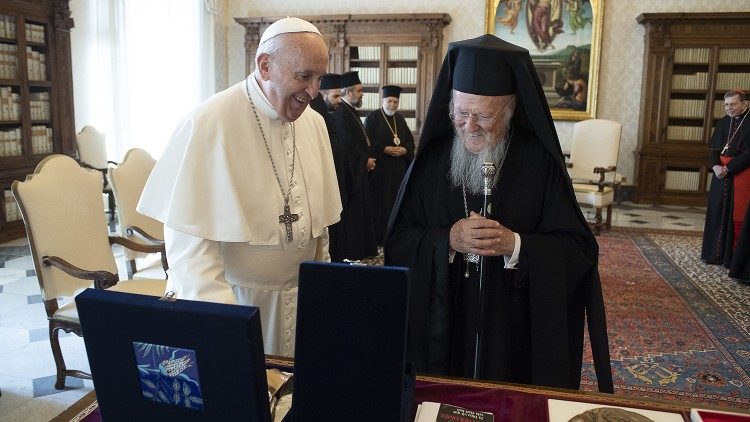epostle
Active Member
- Oct 29, 2019
- 114
- 53
- 73
- Country
- Canada
- Gender
- Male
- Faith
- Catholic
- Marital Status
- Celibate
WHAT ARE THE ROMAN CATACOMBS?
The catacombs are underground tunnels that were forged out of soft rock. They are long, marrow winding corridors. The dead were buried in the walls on either side. From time to time, going through these corridors, one comes to a wider space like a room. In these rooms (formerly occupied by pagans) the Christians would gather for the sacrifice of the Mass so as to worship free from the pagan’s persecutions.
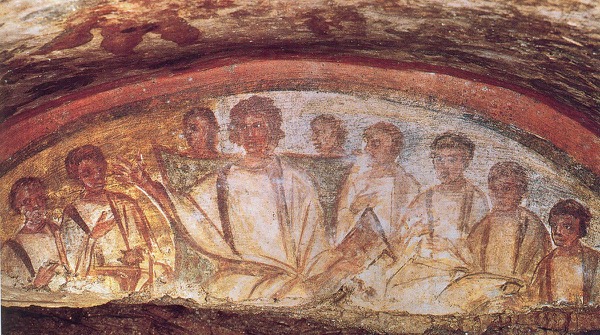
Burial in the catacombs stopped when the barbarians plundered Rome. The popes removed the relics of the saints and martyrs from the catacombs. The catacombs, once abandoned, were gradually forgotten and not discovered again until the end of the sixteenth century. Most famous of the catacombs is that of St. Callistus, where many of the popes were buried after they were martyred for the faith.
The Catacombs of Saint Callixtus. The Christian Catacombs of Rome - Le Catacombe di San Callisto
HOW THE CATACOMBS BEAR WITNESS TO THE TRUE CATHOLIC FAITH TODAY
An authentic Catholic catechism, containing to true Catholic teachings, could be composed from the pictures and inscriptions on the tombs and walls of ancient catacombs of the first three centuries. Pictures, medals, and inscriptions in the catacombs identify the faith of the early Christians with the Catholic faith.
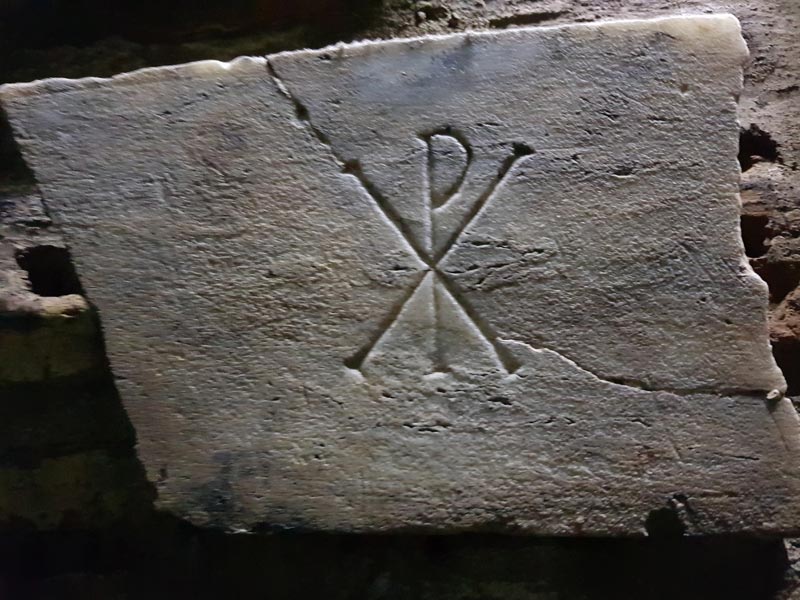 he monogram of Christ is formed by interlacing two letters of the Greek alphabet: X (chi) and P (ro), which are the first two letters of the Greek word "Christòs" or Christ. When this monogram was placed on a tombstone, it meant a Christian was buried there.
he monogram of Christ is formed by interlacing two letters of the Greek alphabet: X (chi) and P (ro), which are the first two letters of the Greek word "Christòs" or Christ. When this monogram was placed on a tombstone, it meant a Christian was buried there.
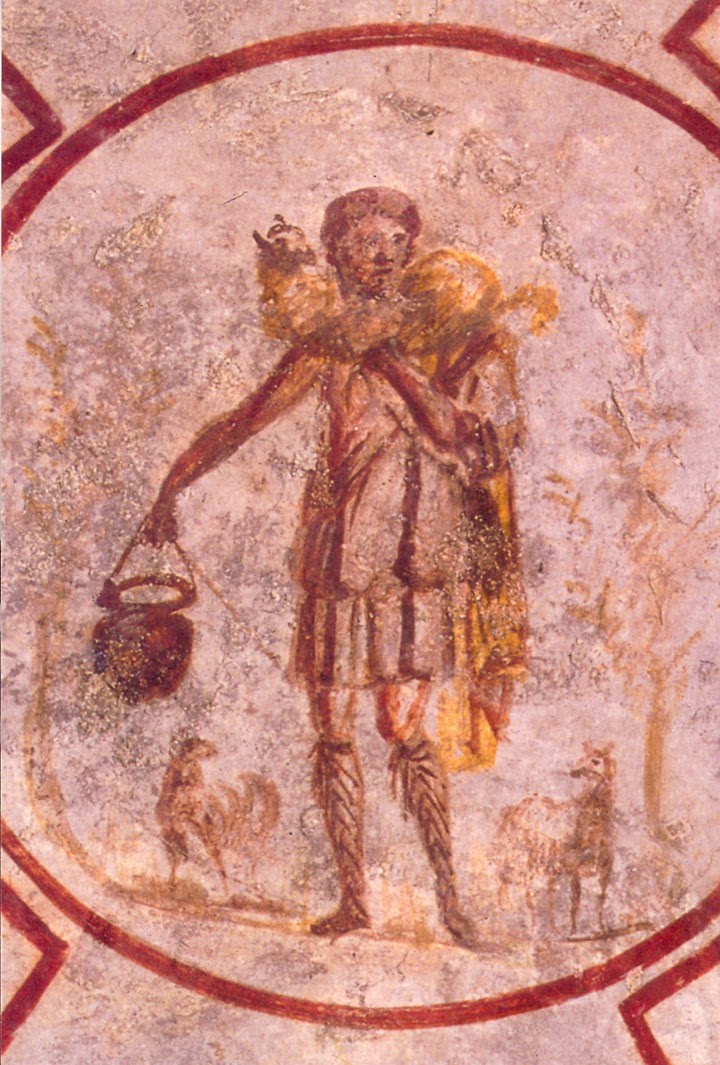
The Good Shepherd with a lamb around his shoulders represents Christ and the soul which He has saved. This symbol is often found in the frescoes, in the reliefs of the sarcophagi, in the statues and is often engraved on the tombs.
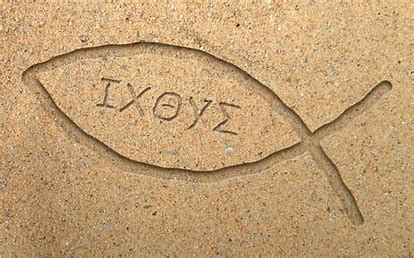
The emblem of the fish, ichthys, was frequently used in the catacombs. It is a symbol of the Lord Jesus, for the Greek word ichthys means “fish” and its letters are the initials for “Jesus Christ, God’s Son, Savior.” When Christians spoke of “receiving the fish”, they meant to receive Jesus in Holy communion.
Frequently, pictures of our Savior in the catacombs reveal him as the Good Shepherd., carrying the lost sheep on his shoulders. This is the ancient biblical form which reveals the same message as our modern devotion to the Sacred Heart of Jesus. A number of people are sitting around a table on which is bread and fish.
Death and resurrection were often in the minds of the early Christians, as indicated by the pictures of Noah and the ark, Jonah and the whale, Daniel in the lions’ den, and the raising of Lazarus. Their faith in resurrection and eternal life gave them courage in facing death under persecution. There is also the famous account of Tarsicius being martyred a he took the holy Eucharist, the bread of life, to Christian prisoners.
The eucharistic sacrifice of the Mass was offered in the catacombs on the altars under which rested the bodies of martyrs. Catholic altars even today have “altar stones” in which the relics of saints and martyrs were placed by bishops when they consecrated the altar stones.
Rev. 6:9 – the martyrs who are seen under the heavenly altar is similar to the Church’s tradition of keeping relics of saints under the earthly altars.
source: A Catechism of the Catholic Church, by Robert J. Fox. Franciscan Herald Press, pgs. 20, 21
The catacombs are underground tunnels that were forged out of soft rock. They are long, marrow winding corridors. The dead were buried in the walls on either side. From time to time, going through these corridors, one comes to a wider space like a room. In these rooms (formerly occupied by pagans) the Christians would gather for the sacrifice of the Mass so as to worship free from the pagan’s persecutions.

Burial in the catacombs stopped when the barbarians plundered Rome. The popes removed the relics of the saints and martyrs from the catacombs. The catacombs, once abandoned, were gradually forgotten and not discovered again until the end of the sixteenth century. Most famous of the catacombs is that of St. Callistus, where many of the popes were buried after they were martyred for the faith.
The Catacombs of Saint Callixtus. The Christian Catacombs of Rome - Le Catacombe di San Callisto
HOW THE CATACOMBS BEAR WITNESS TO THE TRUE CATHOLIC FAITH TODAY
An authentic Catholic catechism, containing to true Catholic teachings, could be composed from the pictures and inscriptions on the tombs and walls of ancient catacombs of the first three centuries. Pictures, medals, and inscriptions in the catacombs identify the faith of the early Christians with the Catholic faith.


The Good Shepherd with a lamb around his shoulders represents Christ and the soul which He has saved. This symbol is often found in the frescoes, in the reliefs of the sarcophagi, in the statues and is often engraved on the tombs.
The emblem of the fish, ichthys, was frequently used in the catacombs. It is a symbol of the Lord Jesus, for the Greek word ichthys means “fish” and its letters are the initials for “Jesus Christ, God’s Son, Savior.” When Christians spoke of “receiving the fish”, they meant to receive Jesus in Holy communion.
Frequently, pictures of our Savior in the catacombs reveal him as the Good Shepherd., carrying the lost sheep on his shoulders. This is the ancient biblical form which reveals the same message as our modern devotion to the Sacred Heart of Jesus. A number of people are sitting around a table on which is bread and fish.
Death and resurrection were often in the minds of the early Christians, as indicated by the pictures of Noah and the ark, Jonah and the whale, Daniel in the lions’ den, and the raising of Lazarus. Their faith in resurrection and eternal life gave them courage in facing death under persecution. There is also the famous account of Tarsicius being martyred a he took the holy Eucharist, the bread of life, to Christian prisoners.
The eucharistic sacrifice of the Mass was offered in the catacombs on the altars under which rested the bodies of martyrs. Catholic altars even today have “altar stones” in which the relics of saints and martyrs were placed by bishops when they consecrated the altar stones.
Rev. 6:9 – the martyrs who are seen under the heavenly altar is similar to the Church’s tradition of keeping relics of saints under the earthly altars.
source: A Catechism of the Catholic Church, by Robert J. Fox. Franciscan Herald Press, pgs. 20, 21
Upvote
0


